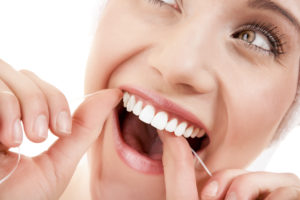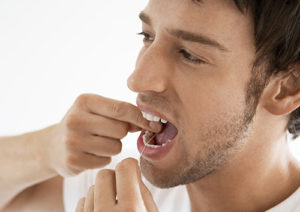The American Dental Association recommends using floss once a day. Patients will often ask if this should be done in the morning or at night. What we find is that as long as you are flossing around the same time each day, then you will be less likely to forget to do it. It’s more about forming a habit and once it is part of your routine you are much less likely to forget.
Without being given proper instructions, it can be tricky to know if you’re doing a good job flossing. Here is a list of Do’s and Don’ts about flossing that will help you stay on track:
DO’S OF FLOSSING
- Do be generous with your floss. You need a piece about 18 inches long to have the correct amount to do a good job
- Do be gentle when pushing down the floss in between the teeth
- Do be sure to get below the gumline as this is where plaque and bacteria hide
- Do wrap the floss around your teeth in a C shape and hold the floss tightly around the tooth
- Do make small circular motions with the floss once it is below the gum line and wrapped firmly around the tooth. This will kick up any of the bacteria that is hiding underneath the gums
- Do be sure to look for products with the ADA seal of approval. This ensure that the material is safe and has been approved using their strict guidelines
- Do use your index or middle finger to wrap the ends of the floss
- Do grab new pieces of floss as you need to while cleaning
- Do make sure to use a one inch of space in your floss inside your mouth
- Do thread the floss out between the teeth to avoid pulling unnecessarily on any fillings or crowns that may be on the teeth
- Do ask your dentist to give you feedback about your hygiene and if they recommend using a water pick, dental rinses, or other tools in addition to floss
DONT’S OF FLOSSING
- Don’t be too aggressive with the floss. You risk harming the gums
- Don’t be stunned about all the different types of floss available to you. If you are unsure which type
 to pick, ask your dentist what they recommend and look for the ADA seal of approval.
to pick, ask your dentist what they recommend and look for the ADA seal of approval. - Don’t be nervous if you see some bleeding while flossing. Keep paying close attention to this spot while flossing and the bleeding should clear up. If it doesn’t, schedule a visit with your dentist to evaluate it
- Don’t be shy about asking for help flossing. It can be tricky to get down the proper technique. Ask your dentist or dental hygienist at your next check-up and cleaning for a demonstration.
- Don’t discourage children from flossing. It is great to teach children how to floss properly at an early age. Make sure to watch them if younger to be sure they are doing it correctly.
- Don’t worry about which comes first, brushing or flossing. It really depends on personal preference. The important piece to note is that the combination of brushing and flossing is best at minimizing the bacteria in your mouth.
- Don’t reuse floss. It is only meant for a one time use.
- Don’t be stingy with floss. As you are flossing you should grab new pieces so that you are not depositing bacteria back into different areas of the mouth.
- Don’t get out of the habit of daily flossing. The toothbrush cannot access in between the teeth and so bacteria hides there. These bacteria will cause cavities and gum disease without proper removal.
Flossing is essential to your oral health. It will prevent gum disease and cavities. Make it part of your routine and remember to do it daily!
